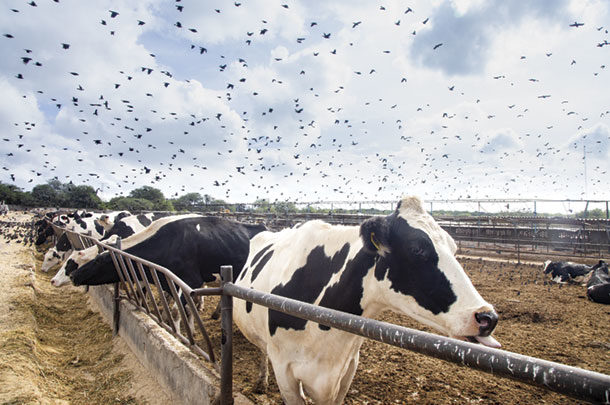Dairy barns are meant to be comfortable and safe housing for cattle. But other animals tend to make a barn their home as well. These uninvited visitors pose a serious threat.
As cooler weather approaches, so do the flocking bird populations on dairy farms. Many different species of birds make a dairy farm “home” in the cooler months, posing a risk not only to the health of livestock and people but also to the producer’s bottom line.
The most common bird to move in is the European starling. Birds, especially starlings, are drawn to livestock operations because of the continuous supply of fresh feed available to them daily. Birds tend to feed on forage bunkers, piles and feedbunks, where they are looking to eat the energy-dense components of the feedstuffs or ration. A starling can eat the equivalent of half its bodyweight in one day. To put that into perspective, it is not uncommon to see a flock of 10,000 starlings during the winter months. If a flock that size was to come through a farm, the birds could possibly eat more than 900 pounds of feed in about a day.
Dairy nutritionists formulate rations to optimize animal performance and health. This loss of nutrients consumed by birds can greatly impact the nutrients the cattle are able to eat, thus directly impacting a producer’s bottom line.
While consumption of feed by birds represents a large economic loss in the livestock industry, it is also associated with the spread and amplification of microbiological hazards. These hazards include E. coli, salmonella and many others that can have lasting impacts in dairy herds. The most common way these pathogens are spread from bird to livestock is the excretion of feces into feed and water sources used by cattle.
In addition to livestock health concerns, birds could potentially spread harmful pathogens to humans as well. Infection of humans is possible via contact with contaminated surfaces. Reducing the carriage of foodborne pathogens in birds, even by small amounts, may have an impact on both public health and the economy.
In today’s world, the solutions to control bird populations by lethal methods are limited, mainly due to strong public opposition. The most common lethal method of controlling starling populations on farm is by using a compound called DRC-1339 (3-chloro-4-methylanilne hydrochloride). DRC-1339 is currently the only toxin for lethal bird control registered by the EPA. However, this method has been under scrutiny due to the slow death of affected birds and the effect it can have on non-target species (i.e., songbirds or other desirable species) that may consume it.
Most of the species of birds that are nuisances on farms (sparrows, pigeons and starlings) are not protected under federal law. Thus, shooting and trapping are also available methods to help control bird populations. However, both can be very time-consuming. Trapping requires constant baiting and maintenance, and then these birds must be humanely euthanized. Shooting of nuisance birds may work best if the on-farm population is small, but safety needs to be addressed with all farm employees.
The good news is: We have other humane ways to manage bird populations and stop them from visiting or making farms their homes for extended periods of time. The best defense is to make the farm less inviting and deter them from coming in the first place. This strategy requires a few different approaches that need to be used in some combination to ensure maximum effectiveness.
Cleanliness is of great importance. Clean up waste feed from outside and around bunkers so it’s not as easily accessible to birds. Seal any holes or gaps birds may use to gain access to buildings where food is plentiful.
Strategies that deter perching in rafters or inside buildings can be used as well. You might consider using netting in open spaces to block access to the rafters. The use of a simple mechanical device, such as sharp wire or barbs on rafters, or chemical agents that make roosting sites sticky or slippery, are common practices used on-farm to deter birds from hunkering down in barns. However, each of these methods can take time and money to maintain over long periods of time.
Harassment devices are another way of deterring birds from staying on a farm for an extended period. Devices such as propane exploders, hawk kites, ultrasonic sounds, pyrotechnics and others have been used extensively on farms. However, if not used at the right time of the year, their effectiveness drops dramatically, and they are not long-term solutions. Once again, some of these devices require an immense focus on safety.
Recently published research investigated ways to deter starling depredation of feedstuffs using different particle sizes of the energy-dense components. Researchers found they could drastically reduce consumption of feed by starlings using a pellet. While this shows some promise to help, more investigation into the cost-effectiveness of this strategy must be done.
For now, the best defense is to make sure there isn’t easily accessible food and water supply and nowhere for the bird to make a “home” on the farm. This takes a combination of cleaning, maintenance and due diligence to ensure the farm is protected from invaders while being cost-effective and safe for non-invasive wildlife populations. When dairy producers successfully prevent a bird invasion, they have in turn protected the health of their cattle and the farm’s bottom line.






